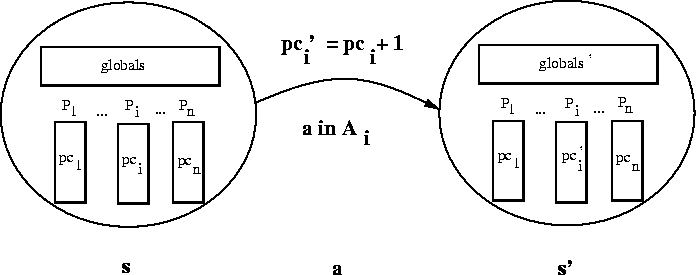We first model each process as a (sequential) state machine.
Thus, we have ![]() and
and
![]() .
The question is ``What is an appropriate state machine model for P ||
Q?''
Before we answer this question,
reconsider the example above, where we have (fortuitously) the simpler
case that
.
The question is ``What is an appropriate state machine model for P ||
Q?''
Before we answer this question,
reconsider the example above, where we have (fortuitously) the simpler
case that ![]() =
= ![]() .
You might like a property like
.
You might like a property like![]() :
:
![]()
but that's clearly not true here! That is, there exists a trace in traces(P || Q) that is not even in traces(P) or traces(Q).
What's going on?
Note that we are assuming each state is a mapping from
variables to values; here, ![]() is the same
set as Var in Handout on State Machine Basics for one machine. Since we have more than
one process, we need to distinguish between the different variable sets.
For simplicity, however, we will assume the same value set, Val,
over which all the different types of variables range.
is the same
set as Var in Handout on State Machine Basics for one machine. Since we have more than
one process, we need to distinguish between the different variable sets.
For simplicity, however, we will assume the same value set, Val,
over which all the different types of variables range.
In what follows, to simplify the notation, for state s and variable
set V, I'll write ![]() to stand for
to stand for ![]() (restriction of the domain of state s to just the variables in V).
I'll also write V = V' to stand for
(restriction of the domain of state s to just the variables in V).
I'll also write V = V' to stand for ![]() (all
variables in V stay the same in value).
(all
variables in V stay the same in value).
Now we can define ![]() as follows:
as follows:
= ¯

where


, and

The sets of locals of each process are mutually disjoint and each set of locals is disjoint with the globals. The intuition is that P can freely change its own locals but not anyone else's and anyone can change any global.
The initial states of the composite machine is the set of all states that are initial when projected onto the domain of each of the constituent state machines.
The set of actions of the composite machine is simply the union of the
sets of actions of the constituent state machines.
Note that if we tagging each action with a process name,
we have ![]() . (If we want shared actions, then
we would not need to pull this trick of tagging each action.)
. (If we want shared actions, then
we would not need to pull this trick of tagging each action.)
=
¯




A step, (s, a, s'), of the composite machine is a step of one of the two machines: if for P, then its pc gets bumped, and all locals of Q stay the same; similarly, if for Q.
The generalization from two to i processes is straightforward.
A picture of a single step transition of a composite machine
with i processes
looks like the following,
where process ![]() gets to change the globals as well as its own
locals.
The locals of all other processes remain the same.
gets to change the globals as well as its own
locals.
The locals of all other processes remain the same.
